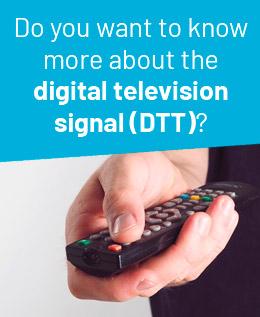
Contents
- 1 How is the digital terrestrial television signal transmitted?
- 2 How many channels do I have to watch on free-to-air TV?
- 3 What about free-to-air digital television?
- 4 What transmission media are used for Digital TV today?
- 5 Flat Parabolic Antennas SAT
- 6 What are Digital Modulators?
- 7 Atresplayer: Your gateway to the world of entertainment with no limits
How is the digital terrestrial television signal transmitted?
Digital TV, (DTT) signal is transmitted via electromagnetic waves in the radio frequency spectrum. This signal is transmitted by a transmitting antenna located on a tower or elevated structure, which broadcasts the signal at a certain frequency in the UHF or VHF band.
The DTT signal is a digital signal, i.e. it is composed of a series of ones and zeros that represent the video, audio and data information that make up the television programme. These ones and zeros are encoded using a data compression system, such as MPEG-2 or MPEG-4, so that they take up less space in the transmission and more channels can be transmitted in the same bandwidth.
The DVB-T signal is received in the home via a receiving antenna, either an outdoor antenna or an indoor antenna, which captures the electromagnetic waves emitted by the transmitting antenna and converts them into an electrical signal. This electrical signal is sent to a set-top box or DTT receiver, which decodes the digital signal and transforms it into the picture and sound displayed on the television.
It is important to bear in mind that the quality of the DVB-T signal can be affected by several factors, such as the distance to the transmitting antenna, the presence of obstacles blocking the signal, interference from other signals or the quality of the receiving antenna. For this reason, it is advisable to have an adequate and well-maintained antenna to receive an optimal DVB-T signal.
How many channels do I have to watch on free-to-air TV?
The number of channels that can be viewed on free-to-air TV depends on several factors, such as the country and region where the TV set is located, the type of TV signal being received (analogue or digital) and the quality of the signal.
In some countries, such as Mexico, up to 30 free-to-air digital terrestrial TV channels can be received, while in other countries the number of channels may be more or less.
It is important to note that the number of channels that can be received may also vary depending on the geographical location and the characteristics of the receiving antenna. In remote areas or areas with obstacles affecting signal reception, it may be difficult to receive all channels available in a given region.
The number of free-to-air TV channels that can be viewed depends on a number of factors, but in general it can be said that in most countries several channels can be received in digital terrestrial signal.
What about free-to-air digital television?
Free-to-air digital television (FTA) is a technology that allows the transmission of television signals in digital format, which means higher picture and sound quality compared to traditional analogue television. In addition, free-to-air digital television offers the possibility of transmitting multiple television channels and additional services such as programme guides, weather information, news, among others.
In many countries, the transition from analogue to digital free-to-air television has taken place in recent years, with the aim of improving the quality of the television signal, increasing the number of available channels and freeing up the radio frequency spectrum for other uses.
HDTV is a technology that continues to evolve and improve, and it is expected that new features and services will continue to be added in the future to enhance the user experience. However, it is important to bear in mind that in order to access free-to-air digital television, it is necessary to have a compatible television set or a DTT decoder, as well as a suitable antenna in good condition to receive the signal correctly.
What transmission media are used for Digital TV today?
There are several transmission media used for current digital TV, the most common of which are:
- Terrestrial transmission: Digital terrestrial television (DTT) is the most common form of television transmission in digital format. It is transmitted via electromagnetic waves in the radio frequency spectrum, and is received by a receiving antenna connected to a DTT set-top box or a TV set with an integrated tuner.
- Cable transmission: Digital cable TV uses fibre optic or coaxial cables to transmit the signal from the TV service provider to the user’s home. To access this signal, a set-top box or receiver provided by the service provider is required.
- Satellite transmission: this is transmitted via radio frequency signals sent from an orbiting satellite to a satellite dish installed in the user’s home. A special set-top box or receiver is required to access this signal.
- Internet broadcasting: IPTV uses the internet connection to transmit signals in real time. This technology allows the transmission of live TV channels and the possibility of accessing content through applications and streaming services.






